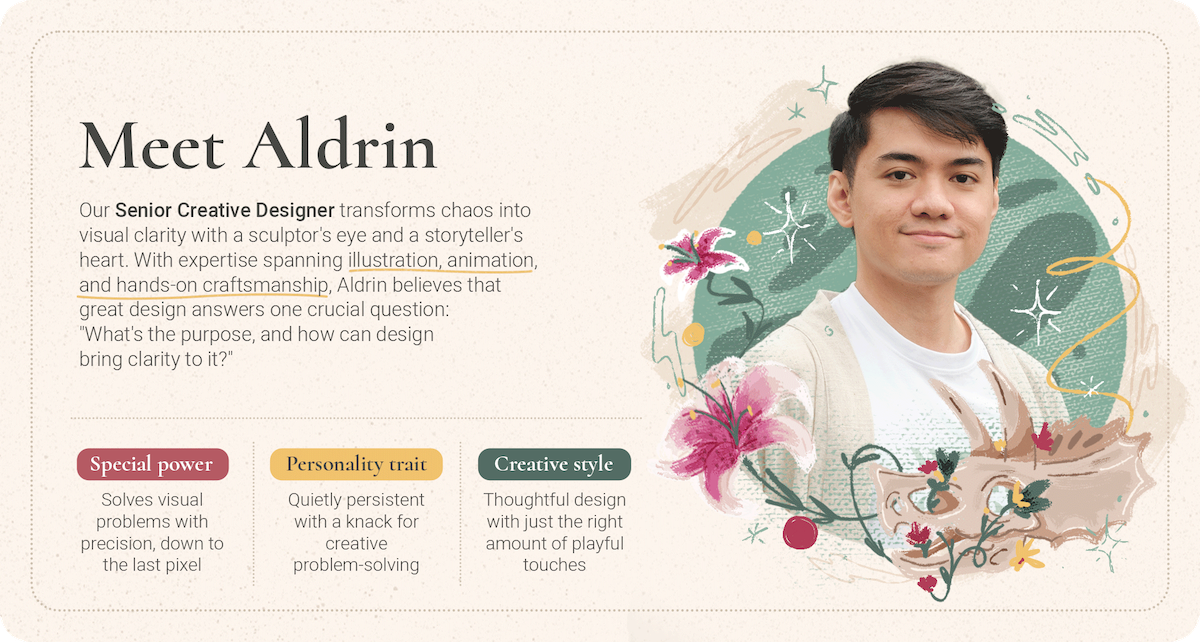We were doing it all wrong.
At least, that’s what the people we consulted told us.
A year later, our experience reflected a whole different story.
In 2018, our team of four (+ a hit squad of 11 excellent freelancers) served close to 60 clients—ranging from seed stage startups to multinational corporations—to the tune of roughly S$200,000 in revenue (just shy of a few grand).
It might not seem like a lot. Heck, any founder with a mere idea can raise that amount in a matter of weeks nowadays. But we count ourselves blessed to have even come this far on our own terms.
We’re profitable. Our team is completely distributed. And we all enjoy the privilege of taking time off anytime we want, regardless of the reason.
Strike one, two, and three.
Many people we consulted on these matters told us it was impossible. And we know they meant well.
I’m here today to tell you that it’s not.
But, it will certainly be a challenging journey.
There were many moments where I found myself aimlessly browsing job boards, fully ready to throw in the towel at the slightest hint that this might not work out.
I hope that the lessons we’re sharing here will encourage potential entrepreneurs to make the leap, or current business owners to stick to their guns and keep going strong.
We believe strongly in transparency, which is why we’re penning this down in the first place: to share the realities of entrepreneurship and life in the trenches. So what we’re sharing might not paint a rosy picture, but hopefully, we can inspire and encourage a business owner or two to learn from our mistakes and find a faster route to success.
I started With Content with nothing but one confirmed customer and a rough idea of the content marketing service I’d offer (which would change drastically over the months). So, plenty of mistakes and learnings to share 😉
So without further ado, here’s what we learned building a calm content marketing agency in one year.
Wait, what is a calm content marketing agency?

Last year, the founders of a well-known web app development company called Basecamp launched a book titled It Doesn’t Have to Be Crazy at Work.
An earlier iteration of its title—and I actually prefer this—was The Calm Company.
Both titles are telling of the book’s main premise: that chaos should not be the natural state at work. Co-founder Jason Fried talks about how they have designed Basecamp differently, to be a calm company:
Calm is profitability.
Calm is protecting people’s time and attention.
Calm is reasonable expectations.
Calm is about 40 hours of work a week.
Calm is ample time off.
Calm is smaller.
Calm is a visible horizon.
Calm is meetings as a last resort.
Calm is contextual communication.
Calm is asynchronous first, real-time second.
Calm is more independence, less interdependence.
Calm is about sustainable practices that can run for the long-term.
For a marketing agency, this is basically heresy.
Agencies are known for long hours, penny-pinching, and their high pressure environments.
Yet, this is exactly how we’ve designed With Content to be: a calm content marketing agency.
This is reflected in our company benefits, which include working from anywhere, unlimited leave, and a work-life-learning allowance to help our employees do their best work wherever, whenever.
Now, let’s get down to the learnings.
1. Naivety might be your greatest advantage
For the past five years, I’ve lived and breathed the startup life.
I’ve worked in leadership positions at startups that didn’t even have a website to their name, to those with over 10 million users around the world. And I’ve written stories about founders who have raised millions of dollars, as well as business owners who bootstrapped from day one without a single cent of external funding.

Yet none of this prepared me for the reality of actually starting and running a business myself—especially an agency, which I had zero experience in prior to starting With Content.
In fact, I would say that my “knowledge” of the startup world might have served as a crutch, leading me to believe that I knew exactly what should happen, and when, in order for With Content to become one of the many success stories I’ve written about.
Here’s the thing: get to know any founder or business owner well, and you’ll find that those “success stories” are mostly hogwash.
I don’t mean to say that the stories are fake. But most of them tend to be simplistic—they downplay all the “hard stuff” that happens in the middle, only focusing on the beginning (“I saw a problem, and I started this as a solution”) and the end (“After overcoming challenge A, B, and C, today we have a gazillion users”).
(You see, it’s really not that easy to tell a good story)
As you can expect, in the early days, nothing turned out the way I thought it would. So much so that I began to question whether longform content—blog posts, case studies, ebooks, and so on—was something that businesses needed.
Basically, I had the business version of a mid-life crisis, albeit right at the start.
So I decided to consult friends in the agency business.
Some were positive about our business model, strongly believing that there was a demand for good storytelling, and that this demand would certainly grow further in the years to come.
On the other hand, others (the majority) were decidedly less optimistic about focusing on delivering longform content only. The margins were too low, they said, and nobody really wants to read stories—they want short, sharp, and sales-focused copy.
(Odd, because research has shown that people really, really don’t like ads)
Naturally, the negative comments hit me the hardest. I mulled over it for weeks, wondering if we should change up our business model and include copywriting as part of our offerings.
Ultimately, however, my naivety won the day. My experience—which had led me to start With Content—told me that tech companies did need high quality, longform content, which in the long run could yield exponential growth for them. I knew by heart many stories of companies who had found success riding the wave of content marketing.

I was ignorant. But that gave me the courage to question the assumptions of experienced agency professionals.
As it turns out, after trying out our services and seeing a boost to their lead generation and SEO efforts, many companies were hooked. Till today, our churn rate remains extremely low, and I’m really grateful for the faith that our clients continue to put in us.
This idea of disrupting what doesn’t make sense, and moving fast to test and see if it works, is precisely why startups have taken over the world. Sadly, many new companies tend to play it safe by following the “formula” that incumbents took to find success.
Resist the urge to fit in. Being different is okay.
2. It’s okay to feel tired
It’s hard to avoid them.
Everywhere you go, they’re staring you down, making you question your ability and generally feel awful about how slack you appear to be.
I’m talking about stories like this and this. Stories that put “superhumans” on a pedestal, and make ordinary human beings (like myself) feel inept.
Like there’s something wrong with us if we’re not able to wake up at 430am in the morning, complete an intense two-hour workout, answer all our emails and achieve Inbox Zero, sit in three meetings simultaneously, and prepare a sumptuous, gourmet breakfast for the family before their alarms even go off—all at the same time.
Being a business owner is tough, particularly at the beginning when you’re still figuring things out. In between admin, accounts, sales, and working on your actual product or service, you’ll definitely be working a lot harder than the average office-goer.
And yes, that means you’re going to be far more exhausted. To the extent that you might dread waking up to yet another workday.
With Content focuses on producing high-quality content. As such, I crafted and delivered countless drafts alone in the early days. So much so that there came a point where I was sick and tired of writing—something that I am extremely passionate about.
How did I overcome it?
I prayed. And then I plowed through. I put my head down and did the work. One foot ahead of the other, one step at a time.
Sorry, no miraculous productivity hacks here. Just a solid dose of reality.
No, I don’t hop out of bed like an Energizer bunny raring to work on my business every day. Conventional wisdom will suggest that perhaps this is not the right fit for me, and I should find my “true passion” somewhere else instead.
But I’m willing to bet a million dollars that the very people we hold in high esteem, like Jack Dorsey and Elon Musk, are not 100% on fire for Twitter and Tesla every moment of every day. I believe that they’re just like us, unable to squeeze every drop of productivity from their day because they get tired, they feel unmotivated—they feel human.
And because that doesn’t quite make for a good story, no one bothers to ask or write about it.
So it’s okay to feel tired. It’s okay to feel like giving up.
Just keep going, and get over the hump. Over time, you’ll find that the humps get less steep.
Soon, you’ll find that you might even be able to hire an employee or two to level those humps even further.
Which brings me to my next point.
3. Trust your team through your actions (not just words)
This is especially tricky for someone who started out solo.
In the first two months of operations, I was the Chief Everything Officer at With Content.
As demand for our services grew, I knew that I couldn’t handle it alone.
So in the six months, I surrounded myself with a team of amazing people. Role by role, I passed it on to them, thinking that I could take myself out of the day-to-day and focus on the bigger picture.
I thought wrong.
As much as I wanted to let go, it was extremely hard not to check in with my colleagues every other minute to make sure that everything was going swimmingly (according to my standards, anyway).
To make things worse, I hate being micromanaged, and had made a promise that I would never be that incessant, annoying presence to my team members. Yet here I was, unable to “break up” with the roles I had passed on.
Things came to a head when we experienced a sharp dip in sales in the middle of the year.
At that time, I questioned many of the things that were fundamental to our business. I believed, for instance, that freedom and autonomy were essential for people to be able to do their best work.
But what if the people I had consulted were right? Could it be that, in the agency world, people just couldn’t be trusted to get work done on their own, and required the stick more than the carrot to perform?
I knew then that I had to make a decision: either get out of the way and let my teammates do their thing, or take back the responsibilities and do it myself.
I chose the former.
Every single time I second-guessed my team, I reminded myself why I had hired them—because I believed they had the potential to be the best.
And with space to breathe, they finally were able to live up to that potential.
Take Katrina, for example. A year ago, she was doing freelance writing for us on a per-piece basis. I was extremely impressed by her strong and consistent writing capability, and ended up offering her a full-time position with us.
Today, she’s taken over the reins as our managing editor, and I completely and wholeheartedly trust any of the decisions that she makes on a daily basis. With her leading our editorial efforts, I can now focus on coming up with new ways to make our clients happy, and solidify our brand name in the market.
Trust your team, because that’s the only way your company will ever grow.
Towards 2019 (and beyond)
As I mentioned at the start of this article, $200k in revenue isn’t much. In fact, our aim was to hit at least $250,000 by the end of 2018.
But we have every reason to be optimistic about 2019. Our sales pipeline is brimming with potential customers, and we’re hoping to double our revenue by the end of next year.
How are we going to do that?
1. Blog posts-as-a-Service
Firstly, we intend to double down on our most popular content offering: blog posts.
Out of every 10 assignments we worked on this year, 8 were articles or blog posts:

Contrary to popular belief, blog posts are well and alive, and in serious demand.
As such, we’ve decided to offer it as a standalone product at a competitive price.
Usually, our pricing per blog post ranges from S$500 to S$700.
From January 2019 onwards, With Content will be offering blog posts as a subscription, on a monthly basis, with a neat 10% discount added on for good measure (minimum of 3 months at the start):
- 4 blog posts per month (up to 2,000 words each): S$1,800
- 8 blog posts per month (up to 2,000 words each): S$3,600
We do have limited slots for this particular service, so if you’re interested, you can sign up here. Fastest fingers first!
Another reason why we’re focusing more on building up our subscriber base in 2019 is because we want to build fruitful, long-term working relationships with our clients.
Of all the retainer clients we’ve worked with this year, only one decided to put our services on hold in December due to a shift in marketing priorities.
It takes time for content marketing to show results. And we want to be the content marketing agency that walks alongside our clients as it unfolds.
2. Be more helpful
I’ll be honest: even though we preach about the value of content marketing to our clients, we just haven’t been able to find the time to focus on our own content marketing efforts.
My goal was to be able to produce a number of essential guides and case studies of content marketing in Singapore, so that more local founders and marketing leads would be exposed to it, and come to a better understanding of how to utilize this powerful tool.
However, I severely underestimated 1) how much client work we’d be bringing in, and 2) how long it’d take me to craft and publish articles that I thought would be valuable to our potential customers.
Putting metal to the pedal, I did manage to publish three blog posts that I’m quite proud of (if I do say so myself):
- The One Reason Why Content Marketing Isn’t Working for You (+ Case Study)
- The True Cost of Good Content (Based on 5 Experts)
- Content Marketing: Pros and Cons of Hiring Freelance vs In-house vs Agency
In 2019, I hope to be able to continue producing at least one solid With Content blog post per month, with a focus on local case studies.
So if you know of any companies in Asia that are doing seriously good work in the content marketing arena (or if you are working in that company), please reach out (drop us an email at hello@withcontent.co)! Happy to tell your story and raise the profile of content marketing in Singapore, and across Asia.
I was also blessed (and very, very humbled) to be interviewed by two publications (one of which will be published in January 2019). Thanks Skyword and That Content Guy for finding With Content interesting enough to feature!
While it does feel slightly odd to be on the other side of the interview table, I’m definitely open to doing more in 2019 to offer more value to the content marketing community, and build With Content’s brand even further.
3. Build more partnerships
A significant amount of work that we’ve accomplished this year has been for larger marketing agencies looking for a specialist in content production.
And we’re more than happy to be in the background, supporting our partners to deliver high-quality content and delight their clients.
As such, we’ll be rolling out a white-label partnership program in Q1 2019 to take this to the next level.
Details are still in the works, but agencies, please do keep your eyes peeled for this.
All in all? We couldn’t be more excited for 2019.
Every day is day one for us at With Content, and it does quite literally feel like we’ve only scratched the surface this year.
Lots more to come. Watch this space!
Have any burning questions to ask?
Drop us an email at hello@withcontent.co, or a message on our contact form, and we’ll try our best to give you a satisfactory answer.
If you’re an agency or service-based business, we’d love to hear about your learnings from 2018 as well.
Here’s to the future of content marketing in Singapore (and Asia) 🍻
(If you liked this, you should check out our 2019 annual review blog post as well)
—
200+ industry-leading tech companies in Southeast Asia are happy clients of With Content. Join them and start delivering valuable content to your potential customers today.



